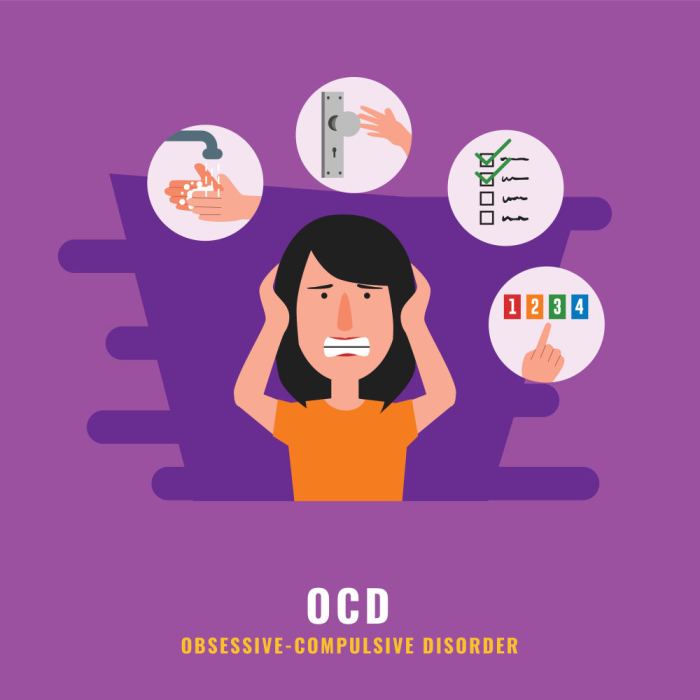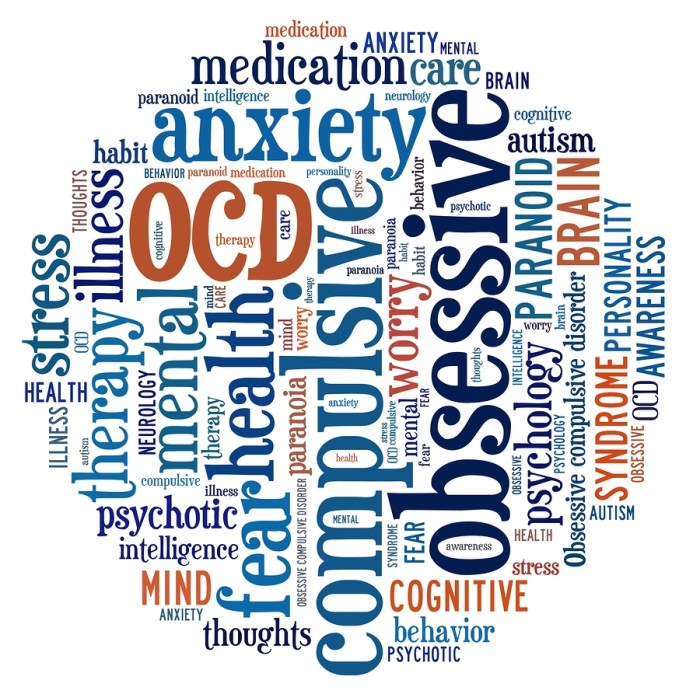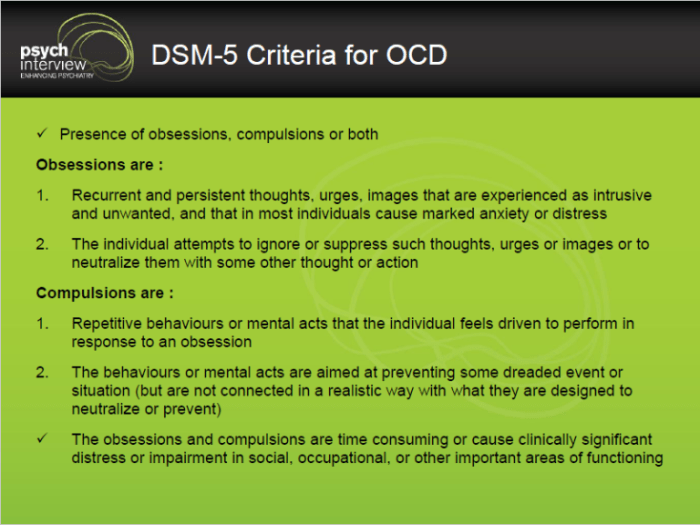Rn anxiety obsessive-compulsive and related disorders assessment – RN Anxiety, Obsessive-Compulsive, and Related Disorders Assessment is a crucial component of mental health care, providing clinicians with the necessary tools to accurately diagnose and develop effective treatment plans for individuals experiencing these conditions. This assessment process involves a comprehensive evaluation of symptoms, utilizing various screening tools, structured interviews, and diagnostic criteria to differentiate anxiety, obsessive-compulsive, and related disorders from other mental health conditions.
This assessment not only aids in diagnosis but also informs treatment planning, ensuring that interventions are tailored to the specific needs of each individual. Ethical considerations are paramount throughout the assessment process, with informed consent, confidentiality, and cultural sensitivity being of utmost importance.
Emerging trends and future directions in assessment are continuously explored, including the potential role of technology and new assessment tools.
1. RN Anxiety, Obsessive-Compulsive, and Related Disorders Assessment: Rn Anxiety Obsessive-compulsive And Related Disorders Assessment

Purpose and Importance:Registered Nurses (RNs) play a vital role in assessing anxiety, obsessive-compulsive, and related disorders (AORDs) due to their frequent patient interactions and ability to recognize symptoms early on. Accurate assessment is crucial for timely diagnosis and appropriate treatment planning.
Assessment Process:The RN assessment process involves gathering subjective and objective data from the patient, including symptom history, current symptoms, and impact on daily functioning. Tools such as self-report questionnaires, structured interviews, and observation can aid in the assessment.
2. Screening and Assessment Tools, Rn anxiety obsessive-compulsive and related disorders assessment
Screening Tools:Common screening tools for AORDs include the Generalized Anxiety Disorder-7 (GAD-7) and the Obsessive-Compulsive Inventory-Revised (OCI-R). These tools provide a quick and easy way to identify individuals who may need further assessment.
Structured Interviews and Diagnostic Criteria:Comprehensive assessment typically involves structured interviews, such as the Anxiety Disorders Interview Schedule (ADIS) or the Diagnostic and Statistical Manual of Mental Disorders (DSM-5) criteria. These tools provide a systematic approach to diagnosing AORDs.
3. Differential Diagnosis
Importance:Differential diagnosis is essential to distinguish AORDs from other mental health conditions with similar symptoms, such as depression, bipolar disorder, and substance use disorders.
Strategies:Strategies for differential diagnosis include carefully reviewing symptom profiles, considering co-occurring conditions, and ruling out other medical or psychiatric conditions that may mimic AORDs.
4. Assessment in Specific Populations
Children and Adolescents:Assessing AORDs in children and adolescents requires specialized knowledge and considerations, as symptoms may differ from adults.
Older Adults:Anxiety and OCD in older adults may be underdiagnosed or misdiagnosed due to age-related factors and co-occurring medical conditions.
Cultural and Linguistic Factors:Cultural and linguistic factors can influence symptom expression and assessment findings. RNs must be culturally sensitive and consider the patient’s background and language preferences.
5. Assessment and Treatment Planning
Informing Treatment Planning:Assessment findings provide a comprehensive understanding of the patient’s symptoms and needs, which guides treatment planning.
Individualized Treatment Plans:Based on the assessment results, RNs collaborate with other healthcare professionals to develop individualized treatment plans that address the specific symptoms and needs of each patient.
6. Ethical Considerations
Informed Consent:RNs must obtain informed consent from the patient before conducting any assessment procedures.
Confidentiality:Patient information must be kept confidential and handled with sensitivity.
Cultural Sensitivity:RNs must respect and acknowledge the cultural and linguistic diversity of patients.
7. Future Directions in Assessment
Emerging Trends:Future directions in AORD assessment include the use of technology, such as mobile apps and online screening tools.
New Assessment Tools:Researchers are continuously developing new assessment tools to improve the accuracy and efficiency of AORD diagnosis.
FAQ Summary
What is the purpose of RN Anxiety, Obsessive-Compulsive, and Related Disorders Assessment?
The purpose of RN Anxiety, Obsessive-Compulsive, and Related Disorders Assessment is to provide clinicians with a comprehensive understanding of an individual’s symptoms and experiences to accurately diagnose and develop effective treatment plans for anxiety, obsessive-compulsive, and related disorders.
What are the common screening tools used in RN Anxiety, Obsessive-Compulsive, and Related Disorders Assessment?
Common screening tools used in RN Anxiety, Obsessive-Compulsive, and Related Disorders Assessment include the Generalized Anxiety Disorder 7-Item Scale (GAD-7), the Obsessive-Compulsive Inventory-Revised (OCI-R), and the Yale-Brown Obsessive-Compulsive Scale (Y-BOCS).
How is differential diagnosis used in RN Anxiety, Obsessive-Compulsive, and Related Disorders Assessment?
Differential diagnosis is used in RN Anxiety, Obsessive-Compulsive, and Related Disorders Assessment to distinguish between anxiety, obsessive-compulsive, and related disorders from other mental health conditions that may present with similar symptoms. This involves a careful evaluation of the individual’s symptoms, history, and presentation to rule out other potential diagnoses.
What are the ethical considerations in RN Anxiety, Obsessive-Compulsive, and Related Disorders Assessment?
Ethical considerations in RN Anxiety, Obsessive-Compulsive, and Related Disorders Assessment include obtaining informed consent, maintaining confidentiality, and ensuring cultural sensitivity. Clinicians must ensure that individuals fully understand the assessment process, their rights, and how their information will be used.


